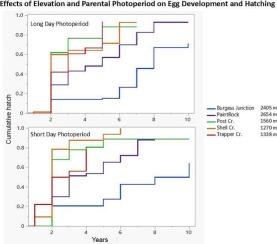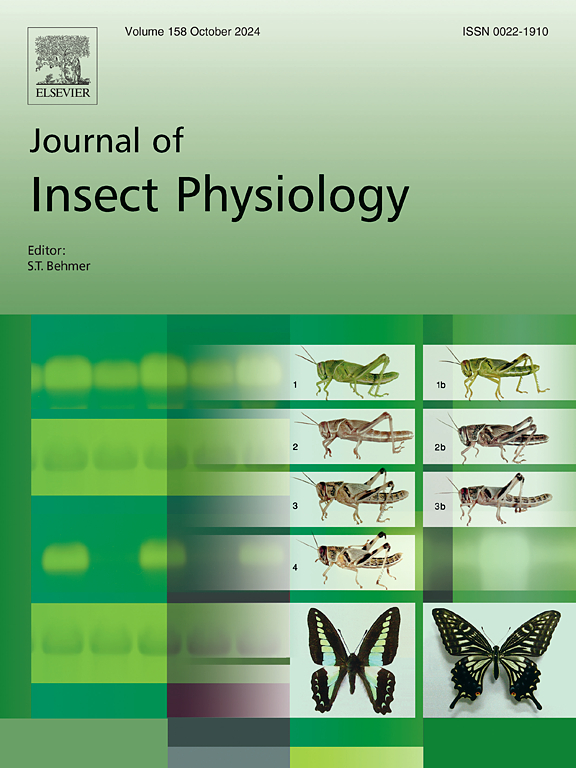亲本光照周期和海拔对单斑小蟋蟀卵滞育、死亡率和同步孵化的影响
IF 2.3
2区 农林科学
Q1 ENTOMOLOGY
引用次数: 0
摘要
有些种类的蝈蝈在卵期停留数年,滞育期延长。由于卵尚未发育神经系统,因此亲代通过成虫的光周期和产卵环境的选择,在决定卵滞育的持续时间方面起着很大的作用。然而,很少有证据比较亲本光周期和卵环境对滞育的相对影响。本研究在海拔1200 ~ 2800 m的7个地点,分别埋藏长日照和短日照的两组单斑摩门蟋蟀卵,研究了光周期和卵环境对滞育的相对影响。正如预测的那样,亲本光周期对后代滞育时间的影响在低海拔地区比在高海拔地区更为明显。与实验室实验的结果相反,短日父母的后代发育得更快。野外实验证实,与环境对卵滞育的影响相比,亲代光周期是延长滞育的软提示。平均孵化时间从2年到8年不等,取决于海拔和微栖息地。土壤温度是决定摩尔门蟋蟀卵在卵库中持续存在的关键因素。此外,短日照期的死亡率更高,特别是在高海拔地区,虫卵在土壤中停留的时间更长。在高海拔地区,胚胎发育的季节很短,只有在白天土壤变热的时候,胚胎才能生长。因此,多年的滞育和缓慢的胚胎发育是高海拔温度的自然结果。山脉和峡谷提供了一个不均匀的热环境,多代卵很可能被储存在土壤中,有利的环境条件可以导致发育同步、孵化和爆发。本文章由计算机程序翻译,如有差异,请以英文原文为准。

Effects of parental photoperiod and elevation on egg diapause, mortality, and synchronous hatching of Mormon crickets Anabrus simplex
Some katydid species remain in the egg stage for multiple years in prolonged diapause. Because the egg has yet to develop a nervous system, the parental generation is believed to play a large role in determining the duration of egg diapause through adult photoperiod and selection of the egg laying environment. However, little evidence exists that compares the relative influences of parental photoperiod and the egg environment on diapause. I investigated the relative effects of parental photoperiod and egg environment on diapause by burying two sets of Mormon cricket Anabrus simplex eggs, one from long-day parents and the other from short-day parents, at seven sites on an elevational gradient (1200–2800 m). As predicted, the effect of parental photoperiod on the diapause duration of the offspring was more pronounced at lower elevations than at high elevation sites. Contrary to results from a laboratory experiment, offspring of short-day parents developed faster. The field experiment confirmed that for Mormon crickets, parental photoperiod is a soft cue for prolonged diapause, especially when compared with the effects of the environment on egg diapause. Median hatching time ranged from two to eight years, depending on the elevation and microhabitat. Soil temperature was a critical factor in determining the persistence of Mormon cricket eggs in egg banks. Moreover, mortality was greater for the short-day photoperiod, particularly at higher elevations where the eggs were in the soil longer. At high elevation sites, the season for embryonic development is short and embryonic growth can only occur when the soil heats up during the day. Hence, multi-year diapause and slow embryonic development is a natural consequence of temperatures at high elevation. Mountains and canyons provide a patchy thermal environment where multiple generations of eggs are likely to be banked in the soil by which favorable environmental conditions can lead to developmental synchronization, hatching, and outbreaks.
求助全文
通过发布文献求助,成功后即可免费获取论文全文。
去求助
来源期刊

Journal of insect physiology
生物-昆虫学
CiteScore
4.50
自引率
4.50%
发文量
77
审稿时长
57 days
期刊介绍:
All aspects of insect physiology are published in this journal which will also accept papers on the physiology of other arthropods, if the referees consider the work to be of general interest. The coverage includes endocrinology (in relation to moulting, reproduction and metabolism), pheromones, neurobiology (cellular, integrative and developmental), physiological pharmacology, nutrition (food selection, digestion and absorption), homeostasis, excretion, reproduction and behaviour. Papers covering functional genomics and molecular approaches to physiological problems will also be included. Communications on structure and applied entomology can be published if the subject matter has an explicit bearing on the physiology of arthropods. Review articles and novel method papers are also welcomed.
 求助内容:
求助内容: 应助结果提醒方式:
应助结果提醒方式:


